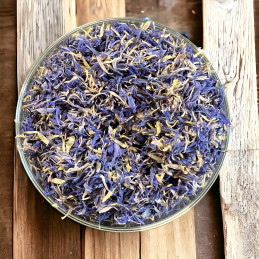
Reference: 112390010





Offered in three different colors (blue, white, or red), these petals are always stunning in color and have numerous medicinal properties!
Use them to decorate salads and potpourris, create soothing lotions for eyes or face, and even enjoy them in infusions
 Delivery
Delivery
Mondial Relay
 Returns
Returns
See conditions
 Payments
Payments
100% secure
Livré en sachet refermable
°°°
Uses in Cooking and Beyond:
Available in three petal colors: blue, white, and red. Blue cornflower is by far the most popular and widespread. The white and red varieties are naturally colored and offer similar benefits to the blue cornflower.
Often called "centaury," from its scientific name, the stunning ultramarine blue petals of cornflower are perfect for decorating summer salads, cakes, ice creams, etc., adding a magical and surprising touch!
You can make your own cornflower water by infusing the petals in hot water for about 10 minutes. Other plants, like rose petals, can be added for variety. This cornflower water serves as a gentle makeup remover, soothes tired eyes, and reduces dark circles. Used as a lotion, it firms and tones the skin, tightening pores. Cornflower water’s benefits degrade with light exposure, so store it in opaque bottles to prolong its shelf life. Cornflower is known for its calming and soothing effects, especially on the eyes (hence its nickname "eyeglass breaker").
With its mild flavor, the petals can even be added to salt in clear salt grinders, creating an unexpected visual effect… The petals are ground together with the salt without altering its taste!
In potpourri, the bright colors enliven the mixture.
For hair rinses, blue cornflower water subtly adjusts the shade of white hair, making cornflower a light dye. By adding an alum crystal to the cornflower water, you’ll get a vibrant pink color; with lemon juice, it turns coral; and by making the water alkaline with a few drops of ammonia, you get a deep blue! This can be a fun experiment for children and offers a color rinse for white hair in your chosen shade. Note, however, that this light coloring doesn’t last very long.
Grinding the petals with sugar creates a natural coloring for creams and candies.
Finally, some baby products contain blue cornflower water for its soothing and softening properties.
Who am I?
Origin: Albania – Gramsh region (blue), Korce region (red), and Cerrik region (white)
Scientific name: Centaurea cyanus
Common names: cornflower, eyeglass breaker, St. Zacharie’s herb, centaury
Harvest period: July/August
Cornflower is an annual or biennial plant growing 30 to 60 cm tall, with slightly downy, greenish-white foliage. The flowers, a striking blue, are commonly found in meadows, roadsides, and fields. Flowers are harvested just after blooming, from March to July.
The delicate, flexible, ultramarine petals create the illusion of a large blue flower from afar. Like all members of the Compositae family, cornflowers are clusters of many small flowers joined together to form a single "bloom."
Cornflowers often grow alongside poppies, as both plants thrive in sunny locations, rich and well-drained soil, and are frequently found near grasses. They are still common in wheat fields that aren’t treated with selective herbicides.
Cornflower is a melliferous flower that attracts bees and even some birds, with probable origins in the Near East.
A Little History:
During World War I, “cornflower” was the nickname given by older soldiers to new recruits because of their light blue uniforms, which replaced the red trousers of older uniforms that had caused heavy casualties. The bright blue uniforms contrasted with the mud-colored ones of veterans. Cornflowers (like poppies) continued to grow on battlefields torn up by shells, bringing a rare touch of color and hope to an otherwise desolate landscape. The young recruits, full of strength and hope, symbolized the only bright spot amid the mud and hardship faced by exhausted veterans.
In the language of flowers, cornflower symbolizes delicacy and shyness.
Data sheet
Reference: 112390010
Reference: mauve
Reference: EPI230206
Reference: souci
Reference: 10M6810601
Reference: rosepetale
Reference: rosepetale
Reference: 6M6533603
Reference: mauve
Reference: 26545D
Reference: jasmin
Reference: 112390010
Reference: souci
Reference: 408190301
Reference: camomilleRom

Offered in three different colors (blue, white, or red), these petals are always stunning in color and have numerous medicinal properties!
Use them to decorate salads and potpourris, create soothing lotions for eyes or face, and even enjoy them in infusions